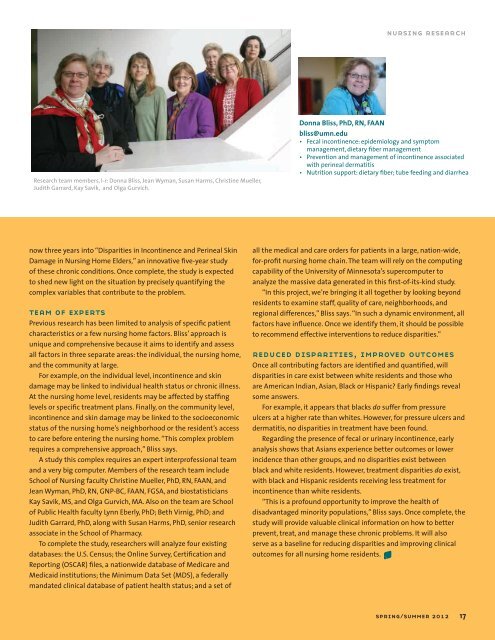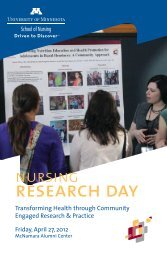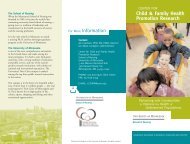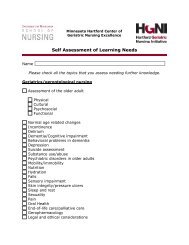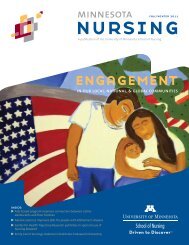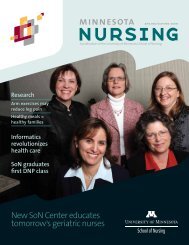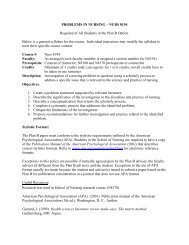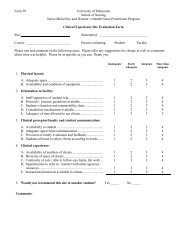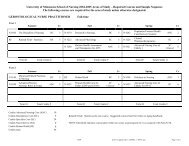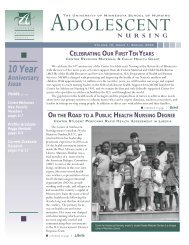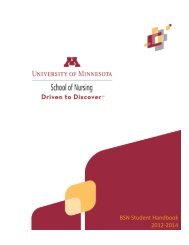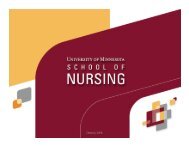Minnesota Nursing Magazine Spring/Summer 2012 - School of ...
Minnesota Nursing Magazine Spring/Summer 2012 - School of ...
Minnesota Nursing Magazine Spring/Summer 2012 - School of ...
Create successful ePaper yourself
Turn your PDF publications into a flip-book with our unique Google optimized e-Paper software.
nursing research<br />
Research team members, l-r: Donna Bliss, Jean Wyman, Susan Harms, Christine Mueller,<br />
Judith Garrard, Kay Savik, and Olga Gurvich.<br />
Donna Bliss, PhD, RN, FAAN<br />
bliss@umn.edu<br />
• Fecal incontinence: epidemiology and symptom<br />
management, dietary fiber management<br />
• Prevention and management <strong>of</strong> incontinence associated<br />
with perineal dermatitis<br />
• Nutrition support: dietary fiber; tube feeding and diarrhea<br />
now three years into “Disparities in Incontinence and Perineal Skin<br />
Damage in <strong>Nursing</strong> Home Elders,” an innovative five-year study<br />
<strong>of</strong> these chronic conditions. Once complete, the study is expected<br />
to shed new light on the situation by precisely quantifying the<br />
complex variables that contribute to the problem.<br />
team <strong>of</strong> experts<br />
Previous research has been limited to analysis <strong>of</strong> specific patient<br />
characteristics or a few nursing home factors. Bliss’ approach is<br />
unique and comprehensive because it aims to identify and assess<br />
all factors in three separate areas: the individual, the nursing home,<br />
and the community at large.<br />
For example, on the individual level, incontinence and skin<br />
damage may be linked to individual health status or chronic illness.<br />
At the nursing home level, residents may be affected by staffing<br />
levels or specific treatment plans. Finally, on the community level,<br />
incontinence and skin damage may be linked to the socioeconomic<br />
status <strong>of</strong> the nursing home’s neighborhood or the resident’s access<br />
to care before entering the nursing home. “This complex problem<br />
requires a comprehensive approach,” Bliss says.<br />
A study this complex requires an expert interpr<strong>of</strong>essional team<br />
and a very big computer. Members <strong>of</strong> the research team include<br />
<strong>School</strong> <strong>of</strong> <strong>Nursing</strong> faculty Christine Mueller, PhD, RN, FAAN, and<br />
Jean Wyman, PhD, RN, GNP-BC, FAAN, FGSA, and biostatisticians<br />
Kay Savik, MS, and Olga Gurvich, MA. Also on the team are <strong>School</strong><br />
<strong>of</strong> Public Health faculty Lynn Eberly, PhD; Beth Virnig, PhD; and<br />
Judith Garrard, PhD, along with Susan Harms, PhD, senior research<br />
associate in the <strong>School</strong> <strong>of</strong> Pharmacy.<br />
To complete the study, researchers will analyze four existing<br />
databases: the U.S. Census; the Online Survey, Certification and<br />
Reporting (OSCAR) files, a nationwide database <strong>of</strong> Medicare and<br />
Medicaid institutions; the Minimum Data Set (MDS), a federally<br />
mandated clinical database <strong>of</strong> patient health status; and a set <strong>of</strong><br />
all the medical and care orders for patients in a large, nation-wide,<br />
for-pr<strong>of</strong>it nursing home chain. The team will rely on the computing<br />
capability <strong>of</strong> the University <strong>of</strong> <strong>Minnesota</strong>’s supercomputer to<br />
analyze the massive data generated in this first-<strong>of</strong>-its-kind study.<br />
“In this project, we’re bringing it all together by looking beyond<br />
residents to examine staff, quality <strong>of</strong> care, neighborhoods, and<br />
regional differences,” Bliss says. “In such a dynamic environment, all<br />
factors have influence. Once we identify them, it should be possible<br />
to recommend effective interventions to reduce disparities.”<br />
reduced disparities, improved outcomes<br />
Once all contributing factors are identified and quantified, will<br />
disparities in care exist between white residents and those who<br />
are American Indian, Asian, Black or Hispanic? Early findings reveal<br />
some answers.<br />
For example, it appears that blacks do suffer from pressure<br />
ulcers at a higher rate than whites. However, for pressure ulcers and<br />
dermatitis, no disparities in treatment have been found.<br />
Regarding the presence <strong>of</strong> fecal or urinary incontinence, early<br />
analysis shows that Asians experience better outcomes or lower<br />
incidence than other groups, and no disparities exist between<br />
black and white residents. However, treatment disparities do exist,<br />
with black and Hispanic residents receiving less treatment for<br />
incontinence than white residents.<br />
“This is a pr<strong>of</strong>ound opportunity to improve the health <strong>of</strong><br />
disadvantaged minority populations,” Bliss says. Once complete, the<br />
study will provide valuable clinical information on how to better<br />
prevent, treat, and manage these chronic problems. It will also<br />
serve as a baseline for reducing disparities and improving clinical<br />
outcomes for all nursing home residents.<br />
spring/summer <strong>2012</strong> 17


